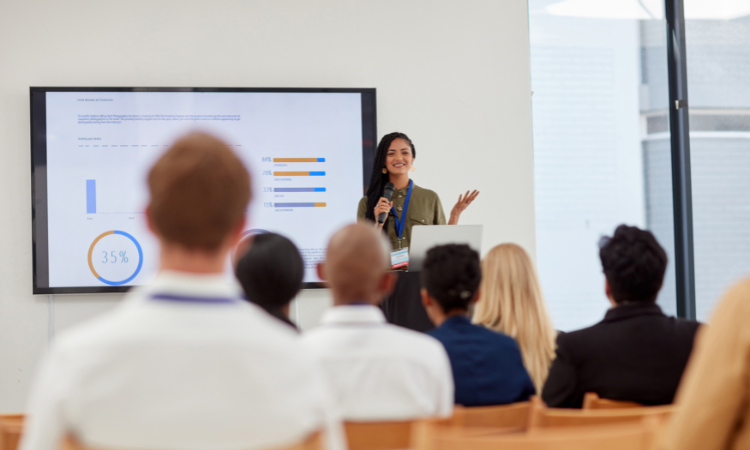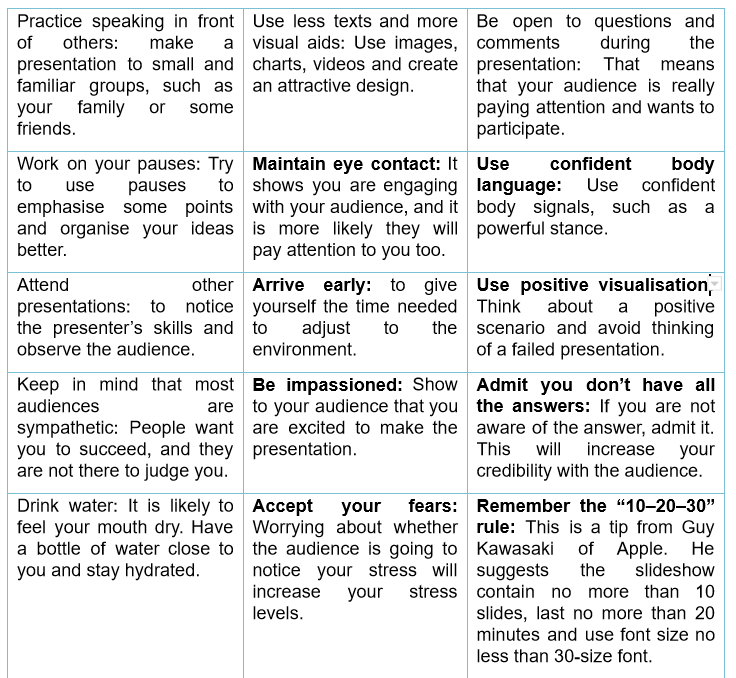Presentation skills

Presentation is a form of communication. We are trying to communicate to the audience our knowledge, beliefs, estimations regarding a specific topic and/or present the results of data analysis or the results of a research etc. A presentation can be adjusted to several speaking situations, such as talking to a small group or to a large audience or addressing a meeting ((c) Copyright skillsyouneed.com 2011–2021, What is a presentation?). The objectives and layout of a presentation may vary. For instance, we could make an oral presentation, or a multimedia one, where we can make use of visual or audio media, a PowerPoint presentation and training sessions or lectures (Chapman, 2020). Therefore, presentation skills are those skills required to deliver efficiently and effectively a presentation to several types of audiences. These skills concern different aspects such as the format of the slides (if there are any), non-verbal signals, like body language, or the structure of the presentation (UBC Wiki, 2020).
Watch this introductory video regarding presentation skills
(5 Things Every Presenter Needs To Know About People, 2012)
Before you start practically developing the material of a presentation, you must contemplate some basic facts, which will help you organize the content effectively and find the most appropriate way to express yourself (Preparing for a Presentation, n.d. Skills you need).
- The objective: the purpose of the presentation. For instance, you might want to teach, stimulate, or inform.
- The audience: you must the size of the audience, the average age, gender, familiarity with the subject, etc.
- The place: be informed about the venue, so that you can be aware of the available equipment, the lighting (in case you need to use visual aids) or the likelihood of outside distractions.
- The time: choose the right time considering people’s needs (food, breaks, interactive activities to stay focused, etc.).
- The duration of the presentation and the likelihood of having to deliver the final material in advance.
Most people feel a little bit fearful or anxious when it comes to a presentation. Preparation and practice are two factors, which help reduce stress levels significantly (Chapman, 2020). More tips to assist you improve your presentation skills are listed below (9 Tips for Improving Your Presentation Skills For Your Next Meeting, 2021; Kim, 2020).

Being able to present your ideas in an appropriate manner is of vital importance in both professional and personal life. Public speaking skills are significant in many professional fields, such as sales and marketing, training, or lecturing (Chapman, 2020). Moreover, managing presentations effectively gives you confidence and is helpful in self – development and in interpersonal relationships. Keep always in mind that the ability of presenting is a skill and as such it can be acquired from anyone. So, keep on practicing!
Activity
Name of the activity:
Continue the story
The aim of the activity:
The goal of the activity is to get the participants familiarized with public speaking and active listening. It gives them the chance to practice some of the tips which are required when making a presentation, such as maintaining eye contact, working on pauses, using confident body language, seeing others speaking in front of an audience, observing the audience’s reactions and accepting their fears.
Skills that the activity develops:
Public speaking, Active listening, Presentation skills, Creativity
How many people the activity is suited for:
Approximately 5 – 10 (Can be more but can’t be less)
Time requirement for the activity:
Depends on the number of the participants and the time they spend talking
How many instructors are needed:
1
Other requirements for the activity:
Open floor space so that the participants can sit in a circle and a device calculating the time each participant should speak
Describe the activity in a clear and concise manner:
The participants sit in a circle of 5 – 10 people (they can be more). One person gets up for about 30 seconds to one minute and starts a story. After the 30 seconds are up the next person gets up and must continue the story from the point the previous participant stopped. This process is repeated until all the participants have spoken. Remember! If you are the next person speaking, the story needs to continue making sense as it goes through. So, you have to pay attention to all the speakers.
Via this activity people also learn how to manage their stress regarding public speaking and little by little they get familiarized with the idea of talking in front of an audience.
https://www.youtube.com/watch?v=qImBpYxW4os&t=25s&ab_channel=CelAmade
References
- (c) Copyright skillsyouneed.com 2011–2021. (2020a). Preparing for a Presentation – Presentation Skills | SkillsYouNeed. https://www.skillsyouneed.com/present/prepare-presentation.html
- (c) Copyright skillsyouneed.com 2011–2021. (n.d.). What is a Presentation? – Presentation Skills | SkillsYouNeed.. https://www.skillsyouneed.com/present/what-is-a-presentation.html
- 5 Things Every Presenter Needs To Know About People. (2012, June 18). [Video]. YouTube. https://www.youtube.com/watch?v=WJUblvGfW6w&ab_channel=SusanWeinschenk
- 9 Tips for Improving Your Presentation Skills For Your Next Meeting. (2021, January 12). Venngage. https://venngage.com/blog/presentation-skills/
- Chapman, A. (2020). Presentation Skills and Techniques. https://www.businessballs.com/communication-skills/presentation-skills-and-techniques/
- Kim, L. (2020, March 5). 20 Ways to Improve Your Presentation Skills. WordStream. https://www.wordstream.com/blog/ws/2014/11/19/how-to-improve-presentation-skills
- Presentation Skills – UBC Wiki. (2020) https://wiki.ubc.ca/Presentation_Skills

